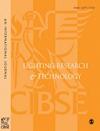日光空间不适眩光研究问卷项目比较
IF 2.2
3区 工程技术
Q2 CONSTRUCTION & BUILDING TECHNOLOGY
引用次数: 0
摘要
在研究不适眩光时,研究者往往依赖于单一的问卷项目来获得用户的评价。目前尚不清楚问卷项目的选择是否会影响用户反应的分布,并导致研究之间的不一致。本研究旨在探讨不同眩光问卷项目在日光环境下是否会产生相似的用户不适分布。我们对以往眩光实验中选定的问卷项目进行了比较研究,并在三个不同照明条件和眩光刺激的独立用户研究中进行了测试。我们比较了来自149名参与者的540个数据点的问卷结果。结果表明,有序问卷输出结果具有较强的相关性(0.68 <ρ& lt;0.85),高内信度(α = 0.93),捕获了相同的潜在构念。二元问卷项目反映了不同的眩光阈值,但与顺序问卷项目仍然具有良好的相关性。通过回答一个开放式问题来确认被测问卷项目的构念效度。这些发现表明,所测试的问卷项目可用于类别评定-类型不适眩光评估,并始终捕获相同的结构。本文章由计算机程序翻译,如有差异,请以英文原文为准。
Comparison of questionnaire items for discomfort glare studies in daylit spaces
When studying discomfort glare, researchers tend to rely on a single questionnaire item to obtain user evaluations. It is unclear whether the choice of questionnaire item affects the distribution of user responses and leads to inconsistencies between studies. This study aims to investigate if different glare questionnaire items yield similar distributions of user discomfort in daylit environments. We conducted a comparative study of selected questionnaire items from previous glare experiments, testing them in three independent user studies with different lighting conditions and glare stimuli. We compared the resulting outputs across questionnaire items with 540 data points from 149 participants. Results indicated that ordinal questionnaire outputs show strong correlations (0.68 < ρ < 0.85), high internal reliability (α = 0.93) and captured the same latent construct. Binary questionnaire items reflected different glare thresholds but still correlated well with ordinal items. The construct validity of tested questionnaire items was confirmed through responses to an open-ended question. These findings suggest that the tested questionnaire items may be used for category rating-type discomfort glare evaluations and consistently capture the same construct.
求助全文
通过发布文献求助,成功后即可免费获取论文全文。
去求助
来源期刊

Lighting Research & Technology
工程技术-光学
CiteScore
5.40
自引率
16.00%
发文量
69
审稿时长
>12 weeks
期刊介绍:
Lighting Research & Technology (LR&T) publishes original peer-reviewed research on all aspects of light and lighting and is published in association with The Society of Light and Lighting. LR&T covers the human response to light, the science of light generation, light control and measurement plus lighting design for both interior and exterior environments, as well as daylighting, energy efficiency and sustainability
 求助内容:
求助内容: 应助结果提醒方式:
应助结果提醒方式:


